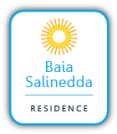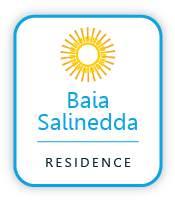A Admission
At the entrance to the residence there is a barrier that restricts the passage of cars. On arrival you will be given the code to digit on the keyboard, located a few metres before the barrier.
B Banks and post
In San Teodoro there are Banco di Sardegna, Banca Intesa and a post office; another branch of Banco di Sardegna is in Porto San Paolo. At Punta Aldia there is a gas station where credit cards are accepted. About 4 km away from the residence, in Vacileddi, there’s a post office.
ATM and credit cards are welcome at the bar and the reception of the residence.
B Boats
The best way to enjoy the coasts of Sardinia is certainly a boat trip. Most of the beaches in the area are equipped to rent inflatable boats. During the high season, excursions by boat are organized from Porto San Paolo (8 km) to Tavolara Island, from Cala Gonone (70 km) to the caves Grotte del Bue Marino and Cala Luna, from Palau (60 km) around the archipelago of La Maddalena. It is possible for guests to bring their own inflatable boats or rafts to the beach by car on the days of arrival and departure. Larger boats can be lowered by a crane in Porto Coda Cavallo (1 km) or Cala Suaraccia (400 m).
C Car
You will need a car to go shopping or explore further afield. If you do not come with your own, you can rent one in Olbia or San Teodoro (a taxi ride from the airport will cost about € 60). You won’t need a car to get to our beach, while the nearby beaches can be easily reached by bike. In high season, try to avoid the road to Olbia in the late afternoon: queues, caused by the traffic to the harbor, are frequent. The streets are all in good condition; driving inland, where gas stations and cars are scarce, you may stumble on a cow behind a curve.
C Climate
The area is characterized by mild climate even during the winter, while summer heat is mitigated by the cool and dry mistral wind blowing from the north. The average annual temperature in most of the region is between 57 and 68 degrees Fahrenheit; during the summer, the average temperature of 86 degrees Fahrenheit can reach 104 degrees in the inland highlands. During the spring average temperatures are around 55 to 57 degrees Fahrenheit.
D Doctors
The nearest doctor is located in San Teodoro, where you will also find a pediatrician, a dentist, an emergency point for tourists and a pharmacy (next to CRAI supermarket). Another pharmacy is located in Porto San Paolo. The nearest hospital is in Olbia (phone: 0789 52.22.00).
F Fire
Fire is a serious danger in Sardinia, especially on windy days, because vegetation in the summer is very dry. Please be especially cautious with anything generating flames. Never turn on fire and call immediately the numbers 115 and 1515 if you see one.
I Irrigation
An automatic watering system is active during the night in all flowerbeds and gardens of the residence. Please be careful not to shift the direction of the sprinklers, and remember the water is recycled and non-potable.
M Mosquitoes
To prevent their proliferation, but with regard to the environment, periodic treatments in the green areas of the residence are made. Nets to be put over the bed can be requested at the reception. Mosquitoes are more frequent in the period of the first summer storms, from mid-August to late September.
N Nightclubs
The proximity to Costa Smeralda allows you to attend the most famous clubs and discos. Many bar and clubs are also located near our residence, at Punta Aldia, San Teodoro and Porto San Paolo.
P Posidonia
During the winter, many of the beaches in the area are covered with high layers of Posidonia, brought by ocean currents. Posidonia is erroneously called seaweed and algae, but is more properly a marine plant that proliferates in the cleanest seas and which is distinguished by a characteristic smell of sulfur. Do not worry: sulfur is good for the skin! And, above all, remember that there are no discharges into the sea at any point on the coast.
Posidonia is important because it prevents the winter storms to erode the beach: for this reason the removal is permitted only with particular caution and previous permission.
W Water
Sea water in Sardinia is among the cleanest in Italy, its colour and transparency have made it famous. Its temperature ranges from 17°C in May to 24°C in August and 20°C in October.
Water supplied in the residence, provided by municipal aqueduct, is drinkable.
In the surroundings of San Teodoro there are some sources of good spring water. The best known is located in the village of Straulas (8 km): take the main road towards Budoni, 2 km after the entrance of the highway, turn right at the junction (there’s a public phone), then keep going another 500 m. In Tempio Pausania, water springs are excellent too.
Museums
We suggest a visit to the Archaeological Museum A.G. Sanna in Sassari, the Ethnographic Museum in Nuoro and the Garibaldi Museum on Caprera Island, inside the building that was once home of Garibaldi. A small Sea Museum is located in San Teodoro; please contact the local tourist office for a visit.
Nuraghe
Nuraghe are towering stone buildings, witnesses of a mysterious Neolithic civilization not yet fully revealed. Along the roads, you will often find the indications to reach them. Tiscali’s Nuraghe, in Dorgali’s Supramonte, is the most famous in the area. Easy to get to is Tomba dei Giganti (Tomb of the Giants) in Arzachena. Other interesting sites are Terralba (Sassari), Macomer (Nuoro), Abbasanta (Oristano), Barrumini (Cagliari).

